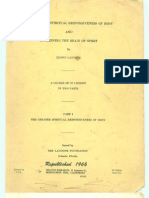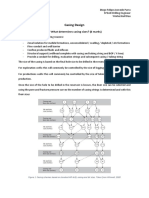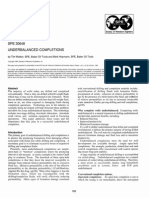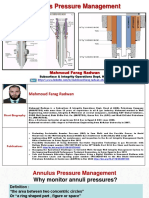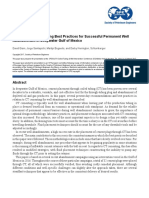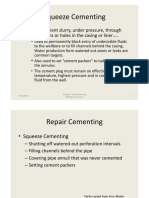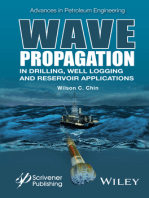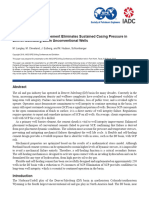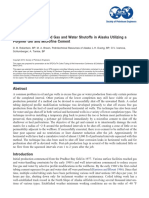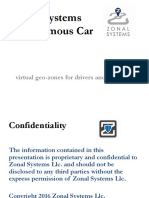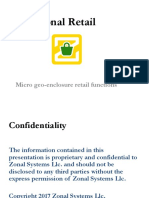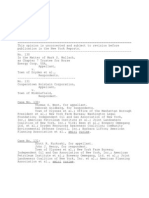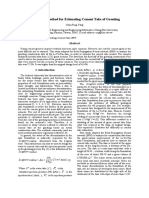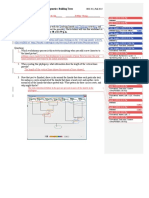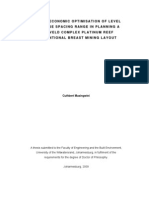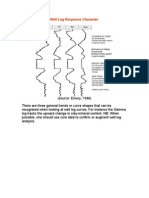Casing Leaks
Casing Leaks
Uploaded by
James "Chip" NorthrupCopyright:
Available Formats
Casing Leaks
Casing Leaks
Uploaded by
James "Chip" NorthrupCopyright
Available Formats
Share this document
Did you find this document useful?
Is this content inappropriate?
Copyright:
Available Formats
Casing Leaks
Casing Leaks
Uploaded by
James "Chip" NorthrupCopyright:
Available Formats
SPE 64733 Why Oilwells Leak: Cement Behavior and Long-Term Consequences
Maurice B. Dusseault, SPE, Porous Media Research Institute, University of Waterloo, Waterloo, Ontario; Malcolm N. Gray, Atomic Energy of Canada Limited, Mississauga, Ontario; and Pawel A. Nawrocki, CANMET, Sudbury, Ontario
Copyright 2000, Society of Petroleum Engineers Inc. This paper was prepared for presentation at the SPE International Oil and Gas Conference and Exhibition in China held in Beijing, China, 710 November 2000. This paper was selected for presentation by an SPE Program Committee following review of information contained in an abstract submitted by the author(s). Contents of the paper, as presented, have not been reviewed by the Society of Petroleum Engineers and are subject to correction by the author(s). The material, as presented, does not necessarily reflect any position of the Society of Petroleum Engineers, its officers, or members. Papers presented at SPE meetings are subject to publication review by Editorial Committees of the Society of Petroleum Engineers. Electronic reproduction, distribution, or storage of any part of this paper for commercial purposes without the written consent of the Society of Petroleum Engineers is prohibited. Permission to reproduce in print is restricted to an abstract of not more than 300 words; illustrations may not be copied. The abstract must contain conspicuous acknowledgment of where and by whom the paper was presented. Write Librarian, SPE, P.O. Box 833836, Richardson, TX 75083-3836, U.S.A., fax 01-972-952-9435.
Abstract Oil and gas wells can develop gas leaks along the casing years after production has ceased and the well has been plugged and abandoned (P&A). Explanatory mechanisms include channelling, poor cake removal, shrinkage, and high cement permeability. The reason is probably cement shrinkage that leads to circumferential fractures that are propagated upward by the slow accumulation of gas under pressure behind the casing. Assuming this hypothesis is robust, it must lead to better practice and better cement formulations Introduction, Environmental Issues This discussion is necessarily superficial, given the complexity of the issue and attendant practical factors such as workability, density, set retardation, mud cake removal, entrainment of formation gas, shale sloughing, pumping rate, mix consistency, and so on. A conceptual model will be developed in this article to explain slow gas migration behind casing, but we deliberately leave aside for now the complex operational issues associated with cement placement and behavior. In 1997, there were ~35,000 inactive wells in Alberta alone, tens of thousands of abandoned and orphan wells1, plus tens of thousands of active wells. Wells are cased for environmental security and zonal isolation. In the Canadian heavy oil belt, it is common to use a single production casing string to surface (Figure 1); for deeper wells, additional casing strings may be necessary, and surface casing to isolate shallow unconsolidated sediments is required. As we will see, surface casings have little effect on gas migration, though they undoubtedly give more security against blowouts and protect shallow sediments from mud filtrate and pressurization.
To form hydraulic seals for conservation and to isolate deep strata from the surface to protect the atmosphere and shallow groundwater sources, casings are cemented using water-cement slurries. These are pumped down the casing, displacing drilling fluids from the casing-rock annulus, leaving a sheath of cement to set and harden (Figure 1). Casing and rock are prepared by careful conditioning using centralizers, mudcake scrapers, and so on. During placement, casing is rotated and moved to increase the sealing effectiveness of the cement grout. Recent techniques to enhance casing-rockcement sealing may include vibrating the casing, partial cementation and annular filling using a small diameter tube. Additives may be incorporated to alter properties, but Portland Class G (API rating) oil well cement forms the base of almost all oil well cements.2 Generally, slurries are placed at densities about 2.0 Mg/m3, but at such low densities will shrink and will be influenced by the elevated pressures (10-70 MPa) and temperatures (35 to >140C) encountered at depth. The consequences of cement shrinkage are non-trivial: in North America, there are literally tens of thousands of abandoned, inactive, or active oil and gas wells, including gas storage wells, that currently leak gas to surface. Much of this enters the atmosphere directly, contributing slightly to greenhouse effects. Some of the gas enters shallow aquifers, where traces of sulfurous compounds can render the water nonpotable, or where the methane itself can generate unpleasant effects such as gas locking of household wells, or gas entering household systems to come out when taps are turned on. Methane from leaking wells is widely known in aquifers in Peace River and Lloydminster areas (Alberta), where there are anecdotes of the gas in kitchen tap water being ignited. Because of the nature of the mechanism, the problem is unlikely to attenuate, and the concentration of the gases in the shallow aquifers will increase with time. This implies that current standards for oilwell cementing and P&A are either not well founded, or the criteria are based on a flawed view of the mechanism. This is not a condemnation of industry: all companies seek to comply with standards.3 Nevertheless, we believe that the AEUB Interim Directive 99034 is flawed with respect to gas leakage around casings. To rectify this, the mechanisms must be identified correctly. Practise can then be based on correct physical mechanisms, giving a better chance of success (though we do not believe
DUSSEAULT, GRAY AND NAWROCKI
SPE 64733
that the problem can be totally eliminated because of the vagaries of nature and human factors, despite our best efforts). There is also need for better quality oil-well cement formulations that can resist thermal shocking. For example, leakage of fluids along thermal wells in cyclic steam operations in Alberta has proven a challenging problem for Imperial Oil.5 If poor quality or poorly constituted cement is used, high injection pressures, thermal shocking, plus non-condensible gas evolution lead to leakage behind the casing that could break to surface under exceptional conditions. Finally, in production management for conservation purposes, zonal isolation is multiple-zone wells.6 There are initiatives to identify old leaking wells and undertake mitigating action in Alberta and Saskatchewan, the orphan well program of the AEUB, initiatives by the Petroleum Technology Alliance Centre in Calgary, and so on. This article is to try and clarify the mechanisms involved. Cement Behavior Cement Shrinkage: If cement is placed at too high a water content, it loses water to the porous strata under lower pressure (po) through direct filtration because the cement hydrostatic head is greater than the pore water pressure head. The annulus width between casing and rock is small (e.g. 175 mm casing in a 225 mm hole = 25 mm), so even a small shear strength development between rock and cement will support the weight of the cement. If this shear stress is only ~0.5 kPa, the entire hydrostatic head of the cement (cz) can be supported by stress transfer to the rock mass. (Of course, because of temperature and pressure effects, this degree of set is not attained simultaneously along the entire cement sheath.) Thus, while the cement is still in an almost liquid, early-set state, massive shrinkage can occur by water expulsion, but annular cement settling to compensate for the loss of water is impeded by the shear stress transfer to the rock mass. The consequence is shrinkage in the cement sheath. Portland cements continue to shrink after setting and during hardening.7,8 This autogenous shrinkage occurs because hydration reaction products occupy less volume than the original paste. Judicious proportioning control of the cement slurry and the use of admixtures and additives can limit the physico-chemical effects of the autogenous shrinkage processes. Mostly, the careful control of water content by using superplasticisers and the control of macro-shrinkage by using appropriate aggregates benefit the properties of the set grouts. Silica flour (SiO2, ground to 20 m) is often used to make thermal cement. It is added in quantities approaching 75% of the dry constituents, the remainder being cement powder. Silica flour has also been added to cement in an attempt to counteract shrinkage. Unfortunately, for physico-chemical reasons, silica flour can enhance both drying and autogenous shrinkage.9 Silica flour is a ground product, usually made from pure quartz sand. Physically, the silica flour, by virtue of its grain size (D50 10-20 m) has a large surface area; this provides
not only enhanced reaction areas for kinetically controlled hydration processes, it provides a need for additional wetting for slurry formulation. Physico-chemically, a freshly fractured silica surface possesses a high chemical reactivity because of the presence of unsatisfied bonds arising from the breaking of the silica chemical lattice. These fresh surfaces will electrostatically bind polar water molecules to satisfy these broken bonds. Experiments on pure silica using magnetic resonance and dielectric permittivity show that up to 9-11 layers of water can be absorbed on the surface, and the closest layers are of course the most tightly bound. The surface area increases inversely as the square of the mean particle diameter, therefore reducing the surface area by a factor of five (grinding 100 m sand to 20 m flour) increases the area by 25, and because the new surface area is chemically fresh, it is more reactive. Thus, the electrostatic bound water volume for silica flour is vastly larger than for geochemically old sand. Furthermore, electrostatically bound water thickness is reduced by temperature (Brownian motion), so cool slurry will have a surfeit of water when it becomes heated through contact with geothermal temperature. Alternative fillers are required to control the macroshrinkage properties of the materials. We recommend 60-100 m quartz sand be substituted for SiO2 flour when possible. Other processes can lead to cement shrinkage. High salt content formation brines and salt beds lead to osmotic dewatering of typical cement slurries during setting and hardening, resulting in substantial shrinkage.10,11 Experiments with recommended cement grout formulations placed against salt and potash strata clearly show massive dewatering of the cement and the formation of free brine at the interface between the cement and the salt. The same effect must occur when freshwater cement grouts are in contact with low permeability rocks with highly saline pore fluids. By ensuring that the grouts are placed at high density, conducive to a stable grout microstructure, the effects of osmotic dewatering can likely be minimized, but this should be quantitatively assessed. Recently marketed finely ground cements (Microfine and Ultrafine) are Portland cement-based materials. They are generally finer than normal Portland cements and include pozzolanic additives, such as finely ground pumice. Slurries of these materials penetrate fine fissures and pores in rock more readily than more conventional grouts but in bulk suffer from very high shrinkage and, hence, without further modification, are not suitable for grouting the annulus between oilwell casings and the borehole wall.12 Dissolved gas, high curing temperatures, and early (flash) set may also lead to shrinkage. It is not clear if non-shrinkage additives have substantial positive effects at great depth and high temperature. These additives (e.g. Al powder) generally produce some gas, which in the laboratory provides volume increase. Additives may enhance some properties; however, they may induce negative impacts on other properties, or lose effectiveness at elevated temperatures, pressures, or in the presence of certain geochemical species. Also, autogeneous shrinkage continues long after these agents have acted.
SPE 64733
WHY OILWELLS LEAK
Cement Strength and Rigidity. API standards for oilwell cement specify certain strength criteria. Strength is not the major issue in oil well cementing under any circumstances. Based on extensive modelling, cement clearly cannot resist the shear that is the most common reason for oilwell distortion and rupture during active production.13 If compaction or heave (from solids injection) is taking place, the cement itself provides minimal resistance to buckling (compression) or thread popping (tension). If the annulus could be filled with relatively dense sand, the resistance to shear would be better than current ordinary oilwell cement formulations. Based on over 50 triaxial tests at various confining stresses, we have shown that 28-day cured oilwell cements are contractile (volume reduction during shear) at all confining stresses above 1 MPa (150 psi). This is also the case for 70% silica flour cements, and for the new products based on extremely finely ground cement. (Specimens were cured under water at 20C or at 90C.) However, dense concretes used in Civil Engineering are dilatant, and therefore resistant to shear, at all working stresses. The stiffness modulus of typical oilwell cement is small compared to that of low porosity rocks, and vastly lower than that of steel.14 The stiffness moduli are roughly 2-4% that of steel, though there is a wide range depending on density, content, and confining stress. Depending on depth (~stress) and induration (~porosity), rock moduli may vary from 2% to 50% of steel, and a reasonable value is 5-15% in most intermediate cases of moderate porosity (10-20%). Bond. Cement will not bond to salt, oil sand, high porosity shale, and perhaps other materials. Also, bond strength (i.e. the tensile resistance of the cement-rock interface) is quite small; in fact, the tensile strength of carefully mixed and cured oilwell cement at recommended formulations is generally less than 1-2 MPa. Given that fluid pressures of 10s of MPa may have to be encountered, given that pressure cycling of a well can easily debond the rock and cement (there is strain incompatibility because of the different stiffnesses), and given that de-bonding is generally a fracturing process with a sharp leading edge rather than a conventional tensile pull-apart process, a large cement bond to rock cannot be assumed in any reasonable case. Initiation and growth of a circumferential fracture (micro-annulus) at the casing-rock interface will not be substantially impeded by a cohesive strength at this interface. The presence of good bond on a cement bond log is in fact not an indicator of bond, but an indicator of intergranular contact maintained by a sufficient radial effective stress. The lack of bond on a bond log is actually evidence of the inability to transmit high frequency sonic impulses because of the presence of an open zone, that is, a circumferential fracture that is open by at least a few microns. Thus, maintaining bond actually means maintaining effective radial stress. Note that if effective radial stress cannot be maintained, then hydraulic fracturing conditions must exist at the interface.
The Gas Leakage Model A good conceptual model must explain the following typical aspects of oilwell behavior that are observed in practice. ! Generally there are no open circumferential fractures detectable after a typical good quality cement job (good bond is observed on the log traces). ! Such fractures develop over time and with service. ! Even in cases where bond appears reasonable over substantial sections of the casing, gas leakage may be evidenced some years or decades later. ! The process is invariably delayed; thus, there must be physically reasonable rate-limiting processes. ! The gas often appears at surface rather than being pressure injected into another porous stratum encountered in the stratigraphic column. ! The presence of surface casing provides no assurance against gas leakage. Whereas we do not deny that mud channeling, poor mud cake removal, gas channeling, and so on can occur in isolated cases, we believe that a better hypothesis exists to rationally explain the points listed above. Figure 2 shows the effect of shrinkage on near-wellbore stresses. (Plots are qualitative, but have been confirmed by numerical modeling, to be published later.) Initially, cement pressure pc(z) = cz, almost always higher than po, but lower than hmin (lateral minimum total stress). Set occurs and a small amount of shear stress develops between the rock and the cement; then, hydrostatic pressure in the cement is no longer transmitted along the annulus. Thereafter, even minor shrinkage (~0.1-0.2%) will reduce the radial stress (r = r + po) between cement and rock because rock is stiff (4-20 GPa for softer rocks), and small radial strains (0.001-0.003) cause relaxation of r and increase in . A condition of po > r (3) is reached; i.e. the hydraulic fracture criterion. A circumferential fracture (i.e. to 3 = r), typically no wider than 10-20 m, develops at the rock-cement interface. A thin fracture aperture is sufficient to appear as loss of bond in a geophysical bond log. Because in situ stresses are always deviatoric (e.g. hmin HMAX), bond loss will usually appear first on one side of the trace, or on two opposite sides (direction of hmin). Wells that have experienced several pressure or thermal cycles will almost always show loss of bond, sometimes for vertical distances in excess of 100 m. A zone of po > r (3) can extend for considerable heights. Nevertheless, this is still not a mechanism for vertical growth. To understand vertical growth, consider Figure 3, where a hypothetical case is presented. The static circumferential fracture of length L is filled with formation water of density w, giving a gradient of about 10.5 kPa/m for typical oilfield brine, but the gradient of lateral stress (h/z) is generally on the order of 18-24 kPa/m. This means that if the fracture contains a fluid pressure sufficient to just keep it open at the bottom, there is an excess pressure at the upper tip equal to ~L(21-10.5) about 10 kPa/m, in typical Alberta conditions, for example. Thus, because of the imbalance between the pressure gradient in the fracture and the stress gradient in the
DUSSEAULT, GRAY AND NAWROCKI
SPE 64733
rock, an inherent fracture propagation force is generated that tends to drive the circumferential fracture upward. (In a perfectly horizontal section, this cannot happen, but the process develops equally at higher elevations in the well where it becomes inclined.) Now, consider what happens when a circumferential fracture between the cement and the rock is exposed to a thin stratum that contains free gas (there are invariably several such zones in any well). Cementing a casing leads not only to the development of a cement sheath, but the cement paste also slightly penetrates the interstitial space in the surrounding rock (a few grain diameters deep for typical sandstone). This reduces the permeability substantially, and because of capillary exclusion effects associated with two-phase flow and the reduced pore throat diameter arising from cement particle invasion, gas flow into the circumferential fractures is almost certainly through diffusion. This means that when the fracture is small, the rate of gas influx is modest. However, as the fracture grows in height, the contact area with surrounding sediments increases, and eventually (and particularly when the pressures are being reduced by surface leakage or flow into a higher stratum), the gas diffusion rate is large enough to lead to continuous but slow gas leakage. In the fracture, once solution gas saturation is achieved, free gas at the top of the fracture develops. The gradient in gas is less than 1 kPa/m (rather than ~10.5 kPa/m for water) so there is an even greater excess driving pressure at the upper tip. In addition, this gradient effect tends to favor driving the liquid in the fracture back into the formation, albeit slowly, and the fracture becomes more and more gas-filled. Thus, there is a self-reinforcing process: the greater the vertical height of the fracture, the greater the excess driving force at the tip. The fracture grows vertically upward, and eventually leads to gas leakage behind the casing at the surface. It will migrate up around the outside of any casing strings at higher elevations because the excess pressure that can be developed at that stage is large enough to fracture even excellent bond (Figure 4). However, why does it take so long for the gas to get to surface (sometimes decades)? Gas must migrate to surface through a circumferential fracture perhaps only 10-20 m thick extending over only a limited part of the circumference of the rock-cement interface. Note that fracture aperture develops between pf and r (= 3) when the pressure acts to maintain it open, but because the rock and cement have elastic stiffness, they act to severely restrict the aperture. Thus, there are at least two rate-limiting aspects to gas evolution at the surface: diffusion rate of gas into the fracture, and the low hydraulic conductivity of the circumferential fracture arising because of its narrow aperture. Why does the fracture grow so slowly? When the microannular circumferential fractures are not connected and are short, the excess pressure at the tip is small. Also, if the casing pressure is large because of production pressure, this leads to a small outward flexure that may be enough to maintain the fissures closed. (Note that if a better bond log response is desired, simply pressurize the casing as the bond log is run!)
As the production pressure declines with time, the fissure will tend to open more because the casing is less pressurized. Also, fracture growth in the vertical direction is undoubtedly aided by pressure and thermal cycles. Nevertheless, it is common for gas bubbling at the surface to be noticeable only years and sometimes decades after P&A. Over time, the effective fracture length increases, and this leads to the driving pressure increase discussed above. Because the velocity of a fracture is a very strongly non-linear process that is positively coupled to the driving pressure, it probably takes years for diffusion processes to lead to a condition where growth starts to accelerate. However, once acceleration begins, the fracture length increases, and complete upward propagation is fast (days? months?), limited only by the rate at which fluids can enter the fracture at depth and flow to the tip. Thus, before P&A, a cement bond log may show that the well is in good condition, yet this is no guarantee that, years later, leakage will not occur. As the fracture rises, the condition that the pressure in the fracture exceeds the pore pressure in the surrounding strata will arise. This will lead to flow from the fracture out into the strata. If this flow is unimpeded, it will occur and the fracture vertical growth will terminate. Now, a condition exists where gas and liquids are entering the wellbore region behind the casing and leaving it at a higher elevation. This is a loss of zonal seal, and could have negative effects, such as pressurizing higher strata, or leakage of brines and formation fluids into shallower strata causing contamination. It can also have positive environmental effects, properly executed. Yet, despite the existence of permeable zones, gas is still observed at the surface, and also as deep-sourced gas in shallow groundwater aquifers. The reason is probably that the cement paste in the pores of permeable strata acts to exclude gas by capillarity effects along the entire length of the stratigraphic column (it takes a large p to overcome surface tension effects in small pores). This means that gas must leave the fracture mainly by liquid-phase diffusion. So, it seems that in leakage cases the flow rate from depth simply exceeds the diffusive bleed-off rate at higher elevations, leading to the excess appearing at the surface. An interesting chromatographic effect probably occurs with mixed gases; because of differing pressure solubility, more soluble gases will diffuse into adjacent strata more rapidly, and the least soluble, CH4, will arrive at the surface almost pure. Unfortunately, even if no gas appears at the surface, it is no guarantee that the well is not leaking. In fact, the common occurrence of household water sources being charged with deep-sourced gas is clear evidence that there are many cases of leakage where the gas simply enters the water aquifer, and may never bubble around the casing. Discussion The hypothesis satisfactorily explains the phenomena associated with well behavior. Thus, it leads to a number of approaches to solve the problem. Eliminating cement shrinkage is one, but there are other practical solutions that are workable.
SPE 64733
WHY OILWELLS LEAK
Cement shrinkage study and the development of new cement formulations that have no Portland phase15 is an ongoing part of an industry-sponsored project, and new formulations will be available soon. Better recommendations for P&A are also being developed. These will be the subjects of other articles. This section will present an approach to environmental protection that can be operationally implemented at present. Given that gas leak-off by Darcy flow (rather than diffusion) is likely impeded by the cement paste in the pore space of adjacent strata, one approach to environmental protection is to complete a well in the manner sketched in Figure 5. The open, non-cemented section is deliberately chosen to be across beds of sufficient permeability so that when excess pressure develops in the zone, the capillary exclusion effect can be overcome (less than 1 MPa typically, but depending on grain size and clay content). Because the rate of gas entry and transmission through the circumferential fracture is small, a permeable bed just a few 10s of centimetres thick will suffice to act as a drain. This bed will accept sufficient volumes of gas, and providing that it is laterally continuous, will act as a drain for a very long time, perhaps indefinitely. Is there a need to revisit API standards on cement formulation, placement and completion practices, and industry quality control during placement?16,17,18 We believe so, but this is a substantial issue, and specific suggestions await more results. Closure The elements of the gas leakage mechanisms that we propose are the following: ! Various mechanisms, but mainly cement shrinkage, lead to a drop in radial stress. ! When r < po, a circumferential fracture will open. ! Differences between lateral stress gradients and pressure gradients provide forces for vertical growth. ! The excess pressure that develops at the upper leading tip increases as the (vertical) height. ! The fracture will tend to become gas filled as gas slowly diffuses into it, increasing the driving force. ! Fracture aperture is severely limited by the stiffness and geometry, limiting the upward propagation rate. ! Pore blockage because of cement paste penetration limits gas leak-off rates to those associated with diffusion because of capillarity effects. ! Eventually the fracture will rise, and gas will enter shallow strata or leak at the surface. This working hypothesis has led to recommendations on cementing and casing strategies, and the pursuit of a cement formulation that can be easily placed yet not shrink is important, both for primary cementing, and for P&A.
References
1 Alberta Energy Utilities Board, 1997. Interim Directive 97-08. LONG TERM INACTIVE WELL PROGRAM REQUIREMENTS. Available from EUB, Calgary Alberta. 2 Ghofrani R. and Marx C. 1990. Special requirements for oilwell cements. In Properties of Fresh Concrete, ed. H. J. Wierig, Chapman and Hall, London, pp. 49-58. 3 Bonett A. and Pafitis D. 1996. Getting to the root of gas migration. Oilfield Review, Spring 1996, pp. 36-49.
4
Alberta Energy Utilities Board, 1999. Interim Directive 9903. SURFACE CASING VENT FLOW/GAS MIGRATION (SCVF/GM) TESTING AND REPAIR REQUIREMENTS. Copy available from the EUB, Calgary Alberta.
Alberta Energy and Utilities Board, 1998. Application Number 970163, In the matter of an application be Imperial Oil Limited for an expansion, Available from AEUB, 10 volumes plus addenda, Calgary, AB. 6 Goodwin, K. J. 1997. Oilwell/gaswell cement-sheath evaluation. J. of Petroleum Tech., December, pp. 1339-1343. 7 Van Breugel 1991. Simulation of hydration and formation of structure in hardening cement-based materials - Delft, NL, 1991 -IBSN 90-9004618-6. 8 Atcin, Neville, Acker 1997. Integrated view of shrinkage deformation - Concrete International, September 1997. 9 Gray, M.N. and Shenton, B.S 1998. Design and Development of Low-Heat, High-Performance, Reactive Powder Concrete. International Symposium on High-Performance and Reactive Powder Concrete, Sherbrooke, PQ, Canada. 1998 August 16-20. 10 Van Kleef, R. P. 1989. Optimized slurry design for salt zone cementations. SPE/IADC 18620, Drilling Conference, New Orleans, Louisiana, pp. 41-49. 11 Chenevert, M. E., Shrestha, B. K. 1991. Chemical shrinkage properties of oilfield cements. SPE Drilling Engineering, Vol. 6, No. 1, pp. 37-43. 12 Gray, M.N. and Shenton, B.S, 1997. Unpublished results of development tests on advanced finely ground cement grout mixtures. Report to the US/DOE, Sandia National Laboratories, Albuquerque, NM 13 Dusseault, M.B., Bruno, M.S., Barrera, J., 1998. Casing shear: causes, cases, cures. SPE#48864. Proc. 1988 SPE International Conf. and Exhibition, Beijing, China, Nov 1998. 14 Thiercelin, M. J., B. Dargaud, J. F. Baret, and W. J. Rodriguez, 1997, Cement Design Based on Cement Mechanical Response, SPE #38598, Proc. Annual Technical Meeting, SanAntonio, TX. 15 Bensted, J. 1996. Slag cement for oil well construction. World Cement, Vol. 27, No. 1, 6 pp. 16 API 1997a, Recommended Practice for Testing Well Cements. Recommended Practice 10B. 146 pages
17
18
API 1997b, Shrinkage and Expansion in Oil Well Cements; Technical report 10TR2, 57 pages
API 1999, Technical Report on Temperatures for API Cement Operating Thickening Time Tests, API 10TR3, 1st Edition, 100 pages
DUSSEAULT, GRAY AND NAWROCKI
SPE 64733
Shallow Heavy Oil Well aquifer
Deep Well
aquifer surficial overlying strata ~300-700 m strata cement sheath casing 1000 5000 m Figure 1: Cased, Cemented Wells liner
slow leakage
gas zone
reservoir
Figure 2: Radial Stresses and Circumferential Fractures hmin direction
r
rock cement casing little to no shrinkage
far-field stress radial stresses pore pressure
high shrinkage case radius Region of low radial stress, leading to hydraulic fracture circumferential fractures due to low r
WHY OILWELLS LEAK
SPE 64733
stress (pressure)
lateral stress, excess driving pressure at top
hmin
gas-filled
pressure in the fracture
typically 1.5-2.2
hmin gradient
gas gradient = 0.1 oil gradient = 0.85 H2O gradient = 1.03
po gas depth entering fracture Figure 3: Fracture Driving Pressure from Gradient Differences
stress (p)
surface casing ineffective fracture propagates upward
maximum gas pressure in microannulus
cased, cemented oilwell gas zone
v h r
depth
Figure 4: Fracture Approaching Surface
reservoir
po
DUSSEAULT, GRAY AND NAWROCKI
SPE 64733
aquifer
surficial
strata
thin
packer
zone with no cement
slow gas seepage along fracture
slow leakage gas zone
Figure 5: Leaving a Leak Off Zone to Arrest Gas Seepage
You might also like
- Awakening The Brain of Spirit Browne LandoneDocument152 pagesAwakening The Brain of Spirit Browne LandoneDawn Mazur100% (21)
- DM27-Casing Design - Diego Felipe Acevedo ParraDocument35 pagesDM27-Casing Design - Diego Felipe Acevedo ParraDiego FelipeNo ratings yet
- Coiled Tubing Operations at a Glance: What Do You Know About Coiled Tubing Operations!From EverandCoiled Tubing Operations at a Glance: What Do You Know About Coiled Tubing Operations!Rating: 5 out of 5 stars5/5 (2)
- INVESTIGATION REPORT eFNCR 076 - BOP Test Plug Stuck in CHHDocument4 pagesINVESTIGATION REPORT eFNCR 076 - BOP Test Plug Stuck in CHHOmer Abd Al NasserNo ratings yet
- Rod Acceleration: by Bruce RichardsDocument4 pagesRod Acceleration: by Bruce RichardsArjuMohamedNo ratings yet
- Underbalance CompletionsDocument7 pagesUnderbalance CompletionsNgo Van HieuNo ratings yet
- 6 PerforatingDocument31 pages6 PerforatingKarwan Ibrahim50% (2)
- Use of Coiled Tubing As A Velocity StringDocument3 pagesUse of Coiled Tubing As A Velocity StringMark Johnson100% (1)
- Logging Through Casing PDFDocument18 pagesLogging Through Casing PDFAlexandru BadescuNo ratings yet
- M-18 Workover Program (DRAFT) 202304020 - Watermark DRAFTDocument16 pagesM-18 Workover Program (DRAFT) 202304020 - Watermark DRAFTنافع ترفاسNo ratings yet
- 02.00.00 - Tool Selection CriteriaDocument70 pages02.00.00 - Tool Selection CriteriaDoni KurniawanNo ratings yet
- OpenHole Sidetrack TechniqueDocument8 pagesOpenHole Sidetrack Techniqueamirawan532No ratings yet
- Superior Packer Setting ProceduereDocument10 pagesSuperior Packer Setting ProcedueretarangtusharNo ratings yet
- Primary Cementing OperationsDocument46 pagesPrimary Cementing OperationsMohammadFidiAbganisHermawan0% (1)
- Total CompletionDocument48 pagesTotal CompletionTarak AbuziadNo ratings yet
- API Purchasing Guide GenericDocument24 pagesAPI Purchasing Guide Genericsajjadn9No ratings yet
- Perforating Technology: China National Logging CorpDocument39 pagesPerforating Technology: China National Logging Corpdarryl_gilbertNo ratings yet
- Annuals PressureDocument18 pagesAnnuals PressureJesus CubillasNo ratings yet
- Perforation: Omega 2013Document73 pagesPerforation: Omega 2013Igbereyivwe TejiriNo ratings yet
- Chapter 3 - Perforating MethodsDocument40 pagesChapter 3 - Perforating MethodsKamran Haider Tunio73% (11)
- 07-Hoan Thien Gieng Optimize PDFDocument93 pages07-Hoan Thien Gieng Optimize PDFGiang Nguyen NinhNo ratings yet
- Chapter 2-HDocument40 pagesChapter 2-HMahrouz MadoNo ratings yet
- Well Control by HelbrtonDocument23 pagesWell Control by Helbrtonاحمد عبد الحسين جولانNo ratings yet
- EOWR CV-5X Combine 08may2008Document85 pagesEOWR CV-5X Combine 08may2008Them Bui XuanNo ratings yet
- TAMU - Pemex Offshore DrillingDocument43 pagesTAMU - Pemex Offshore Drillingdriller22100% (1)
- Well Barrier Gas Lifted ProducerDocument2 pagesWell Barrier Gas Lifted Producerdragan2507No ratings yet
- 13 Remedial SqueezeDocument26 pages13 Remedial SqueezeLenin DiazNo ratings yet
- SPE-175817-MS Case Studies of Formation Isolation Valves For ESP and Intelligent Completions in Multi-Lateral Wells and Horizontal WellsDocument21 pagesSPE-175817-MS Case Studies of Formation Isolation Valves For ESP and Intelligent Completions in Multi-Lateral Wells and Horizontal WellsDarryan Dhanpat0% (1)
- Coiled Tubing Cementing Best Practices For Successful Permanent Well Abandonment in Deepwater Gulf of MexicoDocument10 pagesCoiled Tubing Cementing Best Practices For Successful Permanent Well Abandonment in Deepwater Gulf of MexicoErdal AYDINNo ratings yet
- Section 25 - Wrap Up PDFDocument20 pagesSection 25 - Wrap Up PDFSohaib RashidNo ratings yet
- Tdas West Shell 091602Document15 pagesTdas West Shell 091602amin peyvandNo ratings yet
- Evo-Trieve® EB0 Retrievable Straddle - HalliburtonDocument2 pagesEvo-Trieve® EB0 Retrievable Straddle - HalliburtonYovaraj KarunakaranNo ratings yet
- Cement Dump BailerDocument2 pagesCement Dump BailerfelipeNo ratings yet
- TBG Stress AnalysisDocument2 pagesTBG Stress Analysisazareiforoush0% (1)
- Drilling Technology For The Man On The Rig 7Document37 pagesDrilling Technology For The Man On The Rig 7anzafidandiNo ratings yet
- Coiled Tubing CompletionDocument9 pagesCoiled Tubing Completionreborn2No ratings yet
- Squeeze Cementing: Forces Cement Slurry, Under Pressure, Through Perforations or Holes in The Casing or Liner .Document41 pagesSqueeze Cementing: Forces Cement Slurry, Under Pressure, Through Perforations or Holes in The Casing or Liner .Mehdi AlizadehNo ratings yet
- Pressure Rating For SSII Float EquipmentDocument2 pagesPressure Rating For SSII Float EquipmentMahmoud Ahmed Ali AbdelrazikNo ratings yet
- Causes, Preventioi S, and Recovery of Stuck: PipetDocument10 pagesCauses, Preventioi S, and Recovery of Stuck: Pipetsaeed65No ratings yet
- ExPro Well - Intervention - Brochure PDFDocument20 pagesExPro Well - Intervention - Brochure PDFNaveed HasanNo ratings yet
- MBH-A1 Completion Program - SignedDocument76 pagesMBH-A1 Completion Program - Signed杨建政No ratings yet
- Squeeze Cementing Best PracticesDocument92 pagesSqueeze Cementing Best PracticesTariqNo ratings yet
- Weatherford Water Control Presentation To Customers CARLOS SARAVIADocument20 pagesWeatherford Water Control Presentation To Customers CARLOS SARAVIASebastian Zarate VilelaNo ratings yet
- Primary Cementing Lenin DiazDocument24 pagesPrimary Cementing Lenin DiazGonzalo GabrielNo ratings yet
- Cge578 Chapter 5 Well CPLDocument52 pagesCge578 Chapter 5 Well CPLNurfatini Che100% (2)
- Chapter 7perforationDocument81 pagesChapter 7perforationKarwan Ibrahim100% (2)
- Slickline Basics.11 20Document10 pagesSlickline Basics.11 20Rio de MarioNo ratings yet
- Wave Propagation in Drilling, Well Logging and Reservoir ApplicationsFrom EverandWave Propagation in Drilling, Well Logging and Reservoir ApplicationsNo ratings yet
- Measurement While Drilling: Signal Analysis, Optimization and DesignFrom EverandMeasurement While Drilling: Signal Analysis, Optimization and DesignNo ratings yet
- Sand Control and Gravel Packing Techniques: It Never Rains in the Oil Field!From EverandSand Control and Gravel Packing Techniques: It Never Rains in the Oil Field!Rating: 5 out of 5 stars5/5 (1)
- Spe 163128 MSDocument18 pagesSpe 163128 MSsaeed65No ratings yet
- SPE/IADC 119296 Zonal Isolation Achieved in Kashagan Field Through Integrated ApproachDocument11 pagesSPE/IADC 119296 Zonal Isolation Achieved in Kashagan Field Through Integrated ApproachPAOLA ANDREA DUARTE PRADANo ratings yet
- SPE-187700-MS Optimum Practices To Mitigate Gas Migration Problems in Deep Gas WellsDocument21 pagesSPE-187700-MS Optimum Practices To Mitigate Gas Migration Problems in Deep Gas WellspaimanNo ratings yet
- Thermal Activated ResinsDocument12 pagesThermal Activated Resinsamin peyvandNo ratings yet
- Langley 2018Document9 pagesLangley 2018peymanNo ratings yet
- SPE-173655-MS Coiled Tubing Deployed Gas and Water Shutoffs in Alaska Utilizing A Polymer Gel and Microfine CementDocument15 pagesSPE-173655-MS Coiled Tubing Deployed Gas and Water Shutoffs in Alaska Utilizing A Polymer Gel and Microfine CementIrfan InamdarNo ratings yet
- Cementandwellboreintegrity_ICR_Aug2013Document5 pagesCementandwellboreintegrity_ICR_Aug2013Molybdnum ChannelNo ratings yet
- Cements For Long Term Isolation - Design Optimization by Computer Modelling andDocument14 pagesCements For Long Term Isolation - Design Optimization by Computer Modelling andQutluq Caferzade100% (1)
- SPE 134169 Designing and Testing Cement System For SAGD ApplicationDocument12 pagesSPE 134169 Designing and Testing Cement System For SAGD Applicationadvantage025No ratings yet
- Zonal Systems Patent Application 5th For Security Zones, Parking Zones, RoboZonesDocument153 pagesZonal Systems Patent Application 5th For Security Zones, Parking Zones, RoboZonesJames "Chip" NorthrupNo ratings yet
- Autonomous Vehicle ZonesDocument31 pagesAutonomous Vehicle ZonesJames "Chip" NorthrupNo ratings yet
- Drone Zones: Virtual Geo-Enclosures For Air SpacesDocument30 pagesDrone Zones: Virtual Geo-Enclosures For Air SpacesJames "Chip" NorthrupNo ratings yet
- Zonal Places - Mobile App Geo-EnclosuresDocument31 pagesZonal Places - Mobile App Geo-EnclosuresJames "Chip" NorthrupNo ratings yet
- Zonal RetailDocument30 pagesZonal RetailJames "Chip" NorthrupNo ratings yet
- Zonal Systems US Patent 9317996Document44 pagesZonal Systems US Patent 9317996James "Chip" NorthrupNo ratings yet
- Virtual Reality Shooting Game PatentDocument47 pagesVirtual Reality Shooting Game PatentJames "Chip" NorthrupNo ratings yet
- Zonal Control: Automated Control of Geo-ZonesDocument33 pagesZonal Control: Automated Control of Geo-ZonesJames "Chip" NorthrupNo ratings yet
- Virtual Reality Shotgun Shooting SimulatorDocument35 pagesVirtual Reality Shotgun Shooting SimulatorJames "Chip" NorthrupNo ratings yet
- LeadTech Virtual Reality Shotgun Shooting PatentDocument26 pagesLeadTech Virtual Reality Shotgun Shooting PatentJames "Chip" NorthrupNo ratings yet
- A Public Health Review of High Volume Hydraulic Fracturing For Shale Gas DevelopmentDocument184 pagesA Public Health Review of High Volume Hydraulic Fracturing For Shale Gas DevelopmentMatthew LeonardNo ratings yet
- Gas Pipeline RIght of Way CondemnationDocument56 pagesGas Pipeline RIght of Way CondemnationJames "Chip" NorthrupNo ratings yet
- Wallach v. Town of Dryden, No. 130 and Cooperstown Holstein Corp. v. Town of Middlefield, No. 131 (NY June 30, 2014)Document32 pagesWallach v. Town of Dryden, No. 130 and Cooperstown Holstein Corp. v. Town of Middlefield, No. 131 (NY June 30, 2014)RHTNo ratings yet
- Concepts of Mineral Correlative Rights and Waste and Home RuleDocument53 pagesConcepts of Mineral Correlative Rights and Waste and Home RuleJames "Chip" NorthrupNo ratings yet
- Astrology Notes On Certain Principles Operating On Navamsha by Shridhar Govind JoshiDocument87 pagesAstrology Notes On Certain Principles Operating On Navamsha by Shridhar Govind JoshiPrasanna KumarNo ratings yet
- TraversingDocument38 pagesTraversingjayarb01No ratings yet
- Revisi-Pt. Golden Solomon GuadalcanalDocument23 pagesRevisi-Pt. Golden Solomon GuadalcanalfaidzilchabibcNo ratings yet
- Paper Style MCQ (20) True or False (6) Answer in Detail (15) Answer in Brief (16) Answer in Sentence (15) Experiment (4) Difference (4) MCQDocument19 pagesPaper Style MCQ (20) True or False (6) Answer in Detail (15) Answer in Brief (16) Answer in Sentence (15) Experiment (4) Difference (4) MCQapi-233604231No ratings yet
- Mineral and Rock Classification - Student - VirtualLabGDocument6 pagesMineral and Rock Classification - Student - VirtualLabGTrina WelchNo ratings yet
- Paul PelseneerDocument4 pagesPaul PelseneerjackNo ratings yet
- Köppen Climate Classification - Wikipedia, The Free EncyclopediaDocument15 pagesKöppen Climate Classification - Wikipedia, The Free EncyclopediaAndreea Tataru StanciNo ratings yet
- 1.marie CurieDocument4 pages1.marie CurieEdgar Augusto Pedraza GomezNo ratings yet
- 14 StratigraphyDocument5 pages14 StratigraphyHarsh ShahNo ratings yet
- Using BPN Method For Estimating Cement Take of Grouting: ValueDocument9 pagesUsing BPN Method For Estimating Cement Take of Grouting: ValuehfenangadNo ratings yet
- DSS First Term 2019Document4 pagesDSS First Term 2019jun lampaNo ratings yet
- Peces Del Atlantico Vol I 607Document607 pagesPeces Del Atlantico Vol I 607jessica mendez100% (1)
- The Venerable AstrolabeDocument16 pagesThe Venerable AstrolabeRodica ONESCU100% (1)
- JCR2013IFDocument413 pagesJCR2013IFMehdi AhmadiNo ratings yet
- The Main Issues (Clifford Goldstein)Document16 pagesThe Main Issues (Clifford Goldstein)Rudika PuskasNo ratings yet
- TrigandBearings ExercisesSolutionsDocument8 pagesTrigandBearings ExercisesSolutionsMab DTNo ratings yet
- Final Exam Review SheetDocument2 pagesFinal Exam Review Sheetapi-264668182No ratings yet
- Pagasa 07182019Document5 pagesPagasa 07182019Jhairah DignosNo ratings yet
- Chapter 1Document3 pagesChapter 1wexlerNo ratings yet
- Phylogenetic Trees Activity - Farizah AliDocument2 pagesPhylogenetic Trees Activity - Farizah AliFarizah AliNo ratings yet
- Thesis - Optimization of Level and Raising Spacing Range in Platinum MineDocument228 pagesThesis - Optimization of Level and Raising Spacing Range in Platinum MineCarlos A. Espinoza MNo ratings yet
- 4th ConstellationsDocument5 pages4th Constellationsmj CanilangNo ratings yet
- Full Download The Extended Specimen: Emerging Frontiers in Collections-Based Ornithological Research 1st Edition Webster PDFDocument53 pagesFull Download The Extended Specimen: Emerging Frontiers in Collections-Based Ornithological Research 1st Edition Webster PDFmahupuegebo100% (2)
- On Chomsky and The Two Cultures of Statistical LearningDocument29 pagesOn Chomsky and The Two Cultures of Statistical Learningbobster124uNo ratings yet
- CandlesDocument2 pagesCandlesGregor SamsaNo ratings yet
- Well Log Response CharacterDocument20 pagesWell Log Response CharactertayofelaNo ratings yet
- Generus ClasificadorDocument262 pagesGenerus Clasificadorchristopher suarezNo ratings yet
- 7-Reservoir Modeling PDFDocument34 pages7-Reservoir Modeling PDFmamspaps100% (7)
